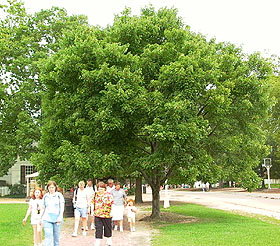Home >
Low drooping branches

Some mature trees can develop large drooping branches if they are not cared for properly. There is nothing inherently wrong with this tree form. However, development of large low drooping branches in urban and suburban landscapes can be problematic when they have to be removed because they are in the way.
Making pruning cuts through old wood opens up a huge portion of the trunk to potential decay (see photo). This can result in hollow columns of decayed or missing wood inside the trunk.
Prevent branches from growing to a large size by pruning the tree at regular intervals. Envision the tree 10 to 20 years from now. Will low branches droop as they grow and be too close to the ground? If that will be the case, reduce their length now, or remove them entirely, so that branches higher in the tree can grow larger.
This technique pushes growth higher up into the canopy. As a result, the tree develops a form closer to the form found in the forest, which is a form the tree can deal with better. The goal for large-maturing shade trees is for the lowest branches to be about 15 to 20 from the ground.
See: more on pruning trees.

